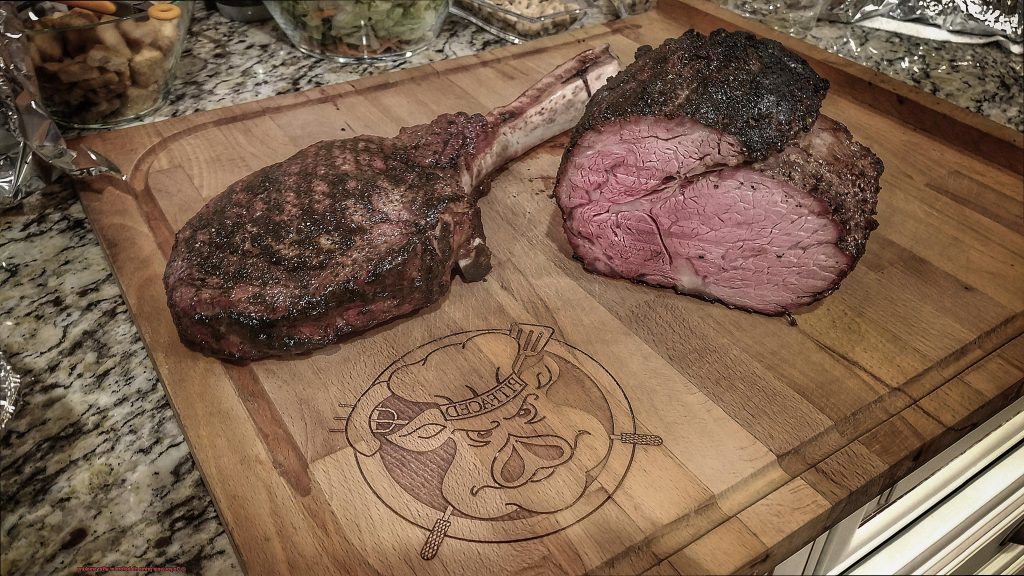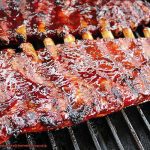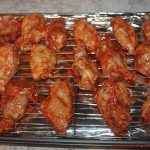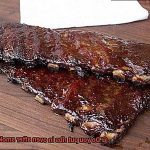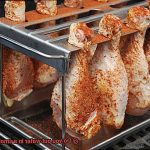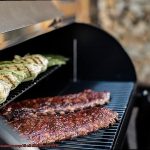Are you ready to take your prime rib game to the next level? If so, you’ve come to the right place. Smoking a prime rib is a surefire way to impress your guests with juicy, flavorful meat that melts in your mouth. But when it comes to searing, things can get a little tricky.
Some people swear by searing their prime rib before smoking it, while others insist on waiting until after it’s been smoked. So which method is best? We’re here to settle the score and give you all the juicy details.
In this blog post, we’ll explore the science behind searing and how it affects the texture and flavor of your meat. From the Maillard reaction to tips for achieving that perfect crust, we’ll cover everything you need to know about searing your prime rib.
Whether you’re a seasoned pro or a first-time smoker, our tips and tricks will help you achieve mouth-watering results every time. So fire up that grill and get ready to impress your guests with a perfectly smoked and seared prime rib that they won’t soon forget.
Contents
Common Techniques for Searing Prime Rib
Well, as an expert in this field, I can tell you that both techniques are perfectly valid and can produce mouthwatering results. Let’s dive deeper into the two common techniques for searing prime rib.
Searing Before Smoking
For those who prefer to sear before smoking, the goal is to create a golden brown crust on the surface of the meat while locking in its juices to enhance its flavor. To achieve this, heat up your grill or pan to a high temperature, then place the prime rib on the surface and sear each side for about 2-3 minutes until it develops a beautifully caramelized exterior. Once seared, transfer the prime rib to the smoker and cook it at a low temperature until it reaches your desired internal temperature. This method can result in a more pronounced crust and tender, juicy meat.
Searing After Smoking
On the other hand, some prefer to smoke their prime rib first and then sear it at high heat. This method allows for a more even cook throughout the entire cut of meat. Smoke the prime rib at a low temperature until it reaches the desired internal temperature, then remove it from the smoker and let it rest for about 15-20 minutes before searing. To sear, heat up your grill or pan to a high temperature and sear each side for about 2-3 minutes until it develops a golden brown crust. This technique can result in a more evenly cooked piece of meat.
Whether you choose to sear before or after smoking your prime rib, always remember to let it rest for at least 10-15 minutes before slicing it into succulent pieces. This step is essential in allowing the juices to redistribute throughout the meat, resulting in a more tender and flavorful cut.
Pros and Cons of Searing Before Smoking
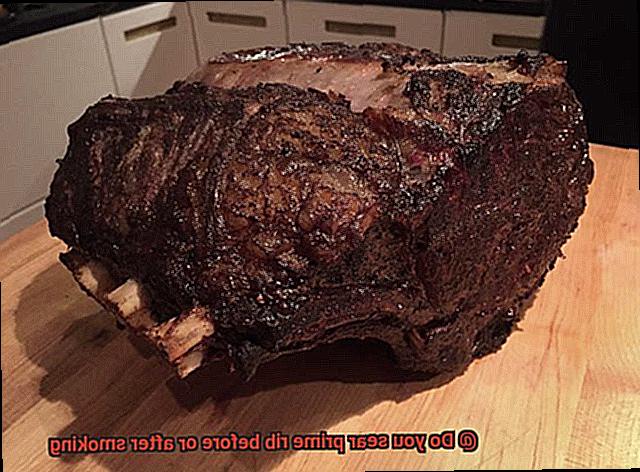
Let’s dive into the pros and cons of this technique, and uncover some helpful tips to ensure success.
First, let’s talk about the benefits of searing before smoking. One major advantage is that it creates a flavorful crust on the outside of the meat, adding depth and complexity to the final dish. In addition, searing can lock in juices and create a more tender end result, making for a truly succulent prime rib.
However, there are potential downsides to consider. Searing can be time-consuming and labor-intensive, especially when dealing with large cuts of meat like a prime rib. Additionally, some argue that searing can cause the meat to dry out during the smoking process, leading to a less juicy and flavorful final product.
Despite these concerns, many chefs swear by searing for the added flavor and texture it provides. If you decide to go this route, consider these tips for success:
- Use high heat: Achieving that coveted crust requires high heat, so make sure your pan or grill is hot enough before adding the meat.
- Keep it short: Sear each side for only a few minutes to avoid overcooking or drying out the meat.
- Don’t overcrowd: Give each piece of meat enough space on the pan or grill to ensure even searing.
Ultimately, whether or not to sear before smoking is a matter of personal preference and experimentation. Some chefs prefer to skip this step altogether to avoid any potential negative effects on tenderness and moisture retention.
Pros and Cons of Searing After Smoking
One of the main arguments in favor of searing after smoking is that it preserves the meat’s delicate flavors. When searing before smoking, high heat can dry out the meat and cause it to lose its natural flavors. However, by searing after smoking, you can achieve a juicy and tender piece of meat that bursts with flavor.
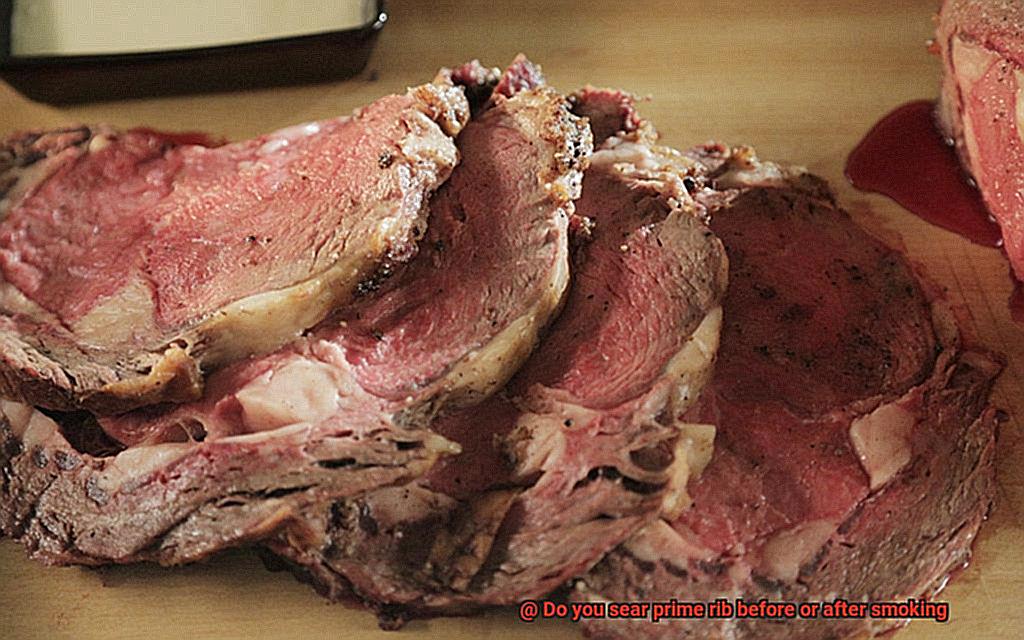
Furthermore, searing after smoking allows for more control over the level of doneness. Searing before smoking can lead to difficulty in achieving uniform doneness since the heat from the sear penetrates into the meat. In contrast, searing after smoking ensures that the interior of the meat is cooked to your desired level while still achieving a crispy crust on the outside.
Nevertheless, there are some drawbacks to searing after smoking. One disadvantage is that it may take longer to achieve a crispy crust on the meat since the surface may be moist from the smoking process. Additionally, if you prefer a heavily charred exterior on your prime rib, searing after smoking may not be your best option.
In summary, choosing whether to sear before or after smoking prime rib is a matter of personal preference. Both techniques have their advantages and disadvantages. However, if you opt for searing after smoking, remember to use high heat, keep it short, and avoid overcrowding the pan or grill.
Tips for Achieving the Perfect Sear
The perfect sear on prime rib is what elevates it from an average cut of meat to a mouthwatering masterpiece. Here are some expert tips to help you achieve that perfect sear and impress your guests.
High Heat Cooking Method
To achieve a perfect sear, you need high heat. Cast iron skillets, grills, and broilers are all excellent options. Preheat your cooking method to high temperature for at least 10 minutes before cooking.
Salt the Prime Rib
Salting the prime rib generously at least an hour before cooking draws out moisture from the surface of the meat, allowing for better browning and a crispy crust.
Dry the Meat
Before searing, pat the surface of the prime rib dry with paper towels. This step is crucial as excess moisture can interfere with the sear and leave you with a lackluster crust.
Choose the Right Oil
For searing, use an oil with a high smoke point like vegetable or canola oil. This will prevent the oil from burning and imparting a bitter taste to your meat.
Sear All Sides
To get even browning and a consistent crust all around, sear all sides of the prime rib, including the ends. This will give you a beautiful caramelized crust on your meat.
Use a Meat Thermometer
To ensure that your prime rib is cooked to perfection, use a meat thermometer to monitor its internal temperature. This will prevent overcooking or undercooking.
How to Smoke a Prime Rib without Searing
Smoking a prime rib without searing is a great way to simplify the cooking process while still achieving a delicious, tender, and juicy end result. Here are five steps to follow:
Prepare Your Smoker
Before firing up your smoker, make sure to preheat it to 225-250°F and add your preferred wood chips or chunks for added flavor. Season your prime rib generously with salt, pepper, and any additional seasoning of your choice.
Place the Prime Rib on the Grates
Once your smoker is up to temperature, place your seasoned prime rib on the grates and let it smoke for several hours until it reaches an internal temperature of around 130-135°F for medium-rare. It’s important to monitor the temperature of the meat throughout the smoking process using a meat thermometer.
Let It Rest
Once the prime rib has reached your desired temperature, remove it from the smoker and let it rest for at least 20 minutes before slicing. This will allow the juices to redistribute throughout the meat and ensure a moist and tender final product.
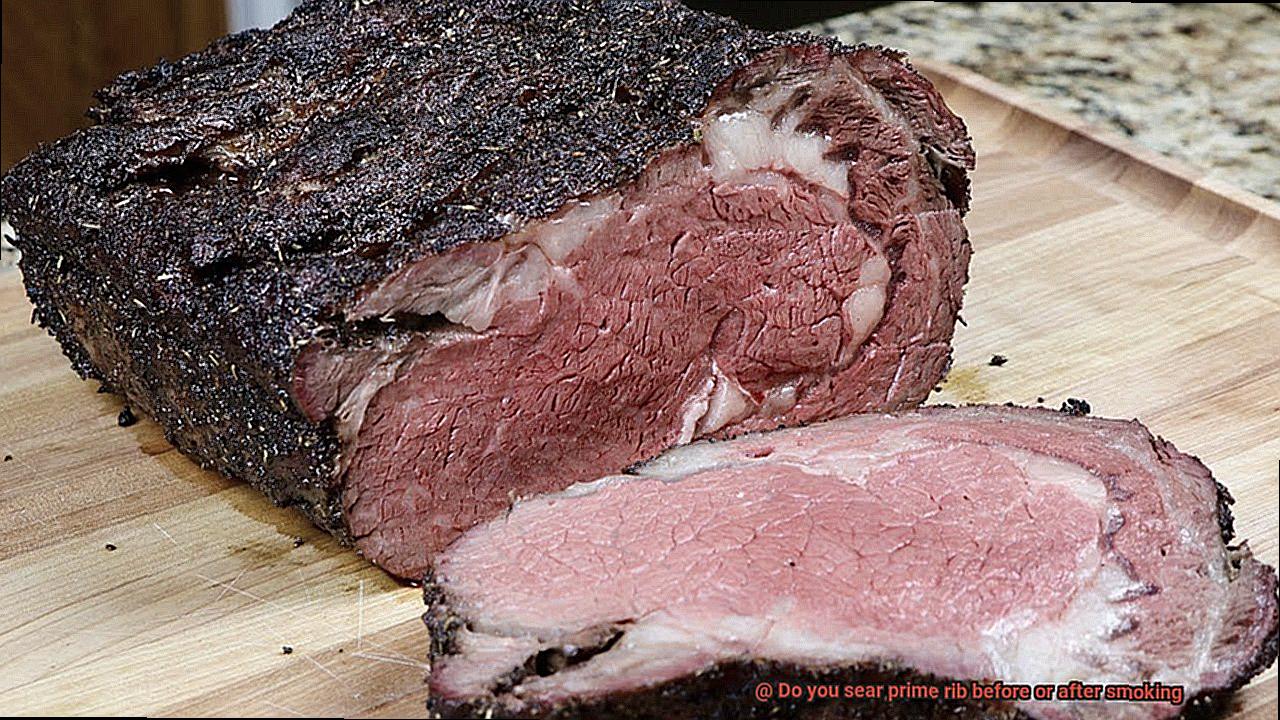
Skip the Searing
Searing is not necessary when smoking a prime rib. The low and slow temperature used during smoking will naturally create a flavorful crust on the meat due to the Maillard reaction. This occurs when proteins and sugars in the meat are heated and react with each other, creating a delicious brown crust.
Experiment with Seared vs. Unseared
While skipping the searing process simplifies the cooking process, some pitmasters prefer to sear their prime rib before smoking for an extra layer of flavor and texture. If you do choose to sear your prime rib before smoking, make sure to do so over high heat for a few minutes on each side before transferring it to the smoker.
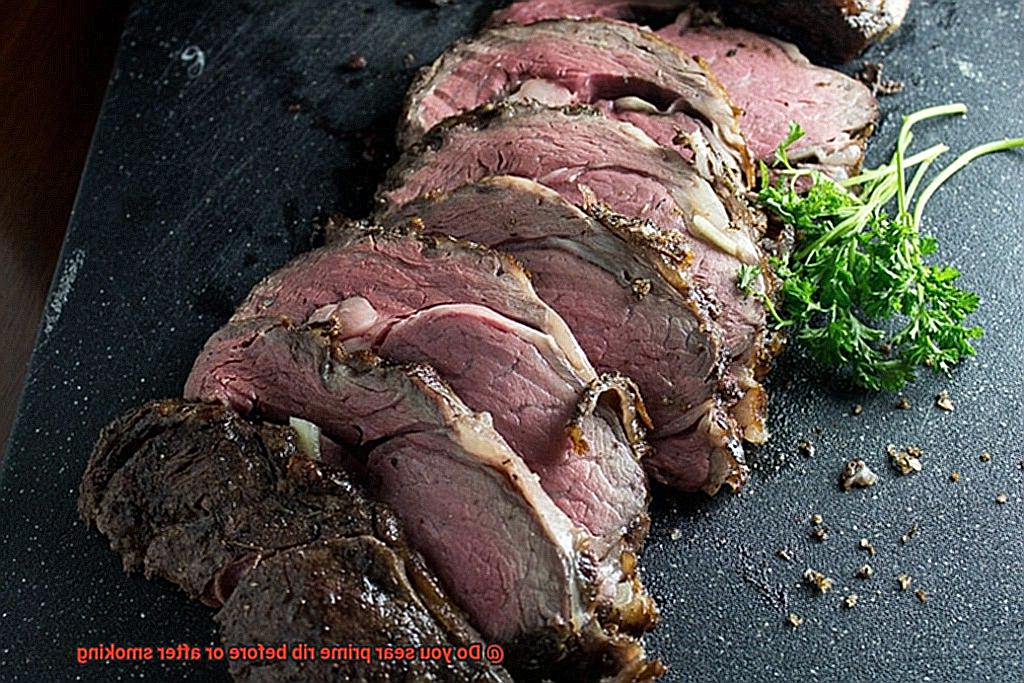
What Temperature Do You Smoke a Prime Rib At?
If you’re a fan of smoked meat, you know that temperature is a crucial factor in achieving the perfect flavor and tenderness. When it comes to smoking a prime rib, the ideal range is between 225 to 250 degrees Fahrenheit. This low and slow cooking method allows the meat to cook evenly and absorb the smoky flavor from the wood chips or pellets used in the smoker.
But don’t forget about the internal temperature. To achieve that juicy, melt-in-your-mouth texture, the internal temperature of the prime rib should reach 135 degrees Fahrenheit for medium-rare, or 145 degrees Fahrenheit for medium. This may take anywhere from 3-5 hours depending on the size of your prime rib.
To take your smoked prime rib to the next level, some experts suggest starting the smoking process at a slightly higher temperature of around 275 degrees Fahrenheit for the first hour. This helps develop a crispy crust on the outside of the meat before lowering it back down to the ideal range for the rest of the smoking process.
As with any smoked meat, it’s important to monitor the internal temperature using a meat thermometer and adjust the smoker’s temperature as needed. And once your prime rib has reached its desired internal temperature, let it rest for at least 15-20 minutes before slicing into it. This will allow the juices to redistribute and ensure maximum flavor.
In summary, here are some key takeaways for smoking a prime rib:
- Ideal range: 225-250 degrees Fahrenheit
- Internal temperature: 135 degrees Fahrenheit for medium-rare, 145 degrees Fahrenheit for medium
- Starting temperature: consider starting at 275 degrees Fahrenheit for the first hour for a crispy crust
- Monitor internal temperature with a meat thermometer and adjust smoker’s temperature as needed
- Let rest for at least 15-20 minutes before slicing into it
How Long Does It Take to Smoke a Prime Rib?
The succulent and juicy flavor of smoked prime rib is a must-try for any foodie out there. But before you embark on this culinary journey, let’s answer the question that’s on everyone’s mind: How long does it take to smoke a prime rib?
Well, my fellow food enthusiast, the answer isn’t as simple as one might think. Smoking a prime rib is a slow cooking process that requires both patience and time. The cooking time can vary depending on several factors, such as the size of the cut and the temperature you choose to smoke it at.
Firstly, let’s talk about the ideal temperature for smoking a prime rib. To achieve the perfect flavor and texture, it is recommended to smoke your prime rib at a temperature range of 225-250°F. This low and slow cooking method will allow the smoke to penetrate deep into your meat, resulting in a flavorful and tender prime rib.
Now, let’s dive into the cooking time. On average, smoking a prime rib can take anywhere from 3-6 hours. However, the cooking time will vary depending on the size of your cut. A 4-pound prime rib might take around 3-4 hours at 225°F, while a larger 10-pound prime rib may take up to 6 hours at the same temperature.
But wait, there’s more. To ensure that your prime rib is cooked to perfection, it is essential to use a meat thermometer. Checking your meat’s internal temperature is crucial to determine its level of doneness. For medium-rare, the internal temperature should read around 130°F, while medium requires 135°F and medium-well needs 140°F.
Troubleshooting Common Issues with Smoking a Prime Rib
Before you get started, let’s talk about some common issues that can arise, especially if you’re new to smoking meat. One of the biggest problems is the tendency for the prime rib to become tough and dry. But don’t fret, because we’ve got you covered with some expert tips to troubleshoot these issues like a pro.
First up, let’s address the age-old debate about when to sear your prime rib. Some experts recommend searing before smoking, while others swear by searing after smoking. So, what’s the deal?
If you’re someone who loves a crispy crust on your meat and wants to lock in the juices and flavor before smoking, then searing before smoking may be the way to go. This helps create a delicious exterior that seals in all the goodness and prevents the meat from drying out during the smoking process.
On the other hand, if you’re someone who wants an even cook throughout the meat without risking overcooking it, then searing after smoking might be more your style. This approach helps ensure that the prime rib is cooked evenly from edge to edge, resulting in a tender and juicy final product.
But here’s the best part: there’s no right or wrong answer. It all depends on your personal preferences and cooking style. If you’re a traditionalist, then searing before smoking might be your go-to method. But if you’re feeling adventurous, why not try skipping the sear altogether and experimenting with different flavors and techniques?
Regardless of which method you choose, keep an eye on your prime rib throughout the smoking process and use a meat thermometer to ensure it’s cooked to perfection. And if you do run into any issues like tough or dry meat, don’t panic. Here are some troubleshooting tips:
- Check your smoker temperature: Make sure your smoker is maintaining a consistent temperature throughout the smoking process.
- Use a meat thermometer: Probing your prime rib at regular intervals can help prevent overcooking and ensure it’s cooked to your desired level of doneness.
- Rest your meat: Allow your prime rib to rest for at least 10-15 minutes after smoking to allow the juices to redistribute and prevent dryness.
vM4PMxAPN3s” >
Conclusion
In conclusion, smoking a prime rib is an impressive and mouth-watering way to elevate your culinary skills. However, when it comes to searing, there are two techniques that can make or break the final result: searing before or after smoking.
Searing before smoking creates a delightful crust on the meat’s surface and locks in its juices for a tender finish. Yet, this method can be time-consuming and may cause the meat to dry out during the smoking process. On the other hand, searing after smoking preserves the delicate flavors of the meat and allows for more control over its doneness. However, it may take longer to achieve that crispy exterior.
Whichever method you choose, remember always to let your prime rib rest for at least 10-15 minutes before slicing into it. This essential step ensures maximum tenderness and flavor as the juices redistribute throughout the meat.
To achieve that perfect sear, use high heat, generously salt beforehand, thoroughly dry the meat’s surface, choose an oil with a high smoke point like vegetable or canola oil, sear all sides evenly and monitor internal temperature using a meat thermometer.
Lastly, if you’re new to smoking meat or run into any issues such as tough or dry meat during cooking process check smoker temperature regularly using a thermometer probe and allow enough resting time before serving.
With these tips and tricks under your belt, you’re well on your way to mastering smoked prime rib like a pro.

